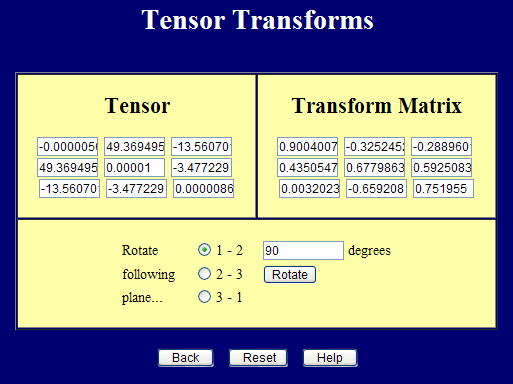Introduction
This page introduces hydrostatic and deviatoric stresses. The two are subsets of any given stress tensor, which, when added together, give the original stress tensor back. The hydrostatic stress is related to volume change, while the deviatoric stress is related to shape change.Hydrostatic Stress
Hydrostatic stress is simply the average of the three normal stress components of any stress tensor.\[ \sigma_{\text{Hyd}} = {\sigma_{11} + \sigma_{22} + \sigma_{33} \over 3} \]
There are many alternative ways to write this.
\[ \sigma_{\text{Hyd}} \; = \; {1 \over 3} \text{tr}(\boldsymbol{\sigma}) \; = \; {1 \over 3} I_1 \; = \; {1 \over 3} \sigma_{kk} \]
It is a scalar quantity, although it is regularly used in tensor form as
\[ \boldsymbol{\sigma}_{\text{Hyd}} = \left[ \matrix{\sigma_{\text{Hyd}} & 0 & 0 \\ 0 & \sigma_{\text{Hyd}} & 0 \\ 0 & 0 & \sigma_{\text{Hyd}} } \right] \]
Hydrostatic Stress Example
\[ \boldsymbol{\sigma} = \left[ \matrix{ 50 & \;\;\; 30 & \;\;\;20 \\ 30 & -20 & -10 \\ 20 & -10 & \;\;\;10 } \right] \]
The hydrostatic stress is
\[ \sigma_\text{Hyd} \, = \, {50 + (-20) + 10 \over 3} \, = \, 13.3 \]
which can be written as
\[ \boldsymbol{\sigma}_\text{Hyd} = \left[ \matrix{ 13.3 & 0 & 0 \\ 0 & 13.3 & 0 \\ 0 & 0 & 13.3 } \right] \]
And that's all there is to it.
Hydrostatic Stresses and Coordinate Transformations
This could not be simpler. Hydrostatic stresses do not change under coordinate transformations. This is easily accepted in light of the fact that \(\sigma_\text{Hyd}\) is a function of \(I_1\). Also\[ \boldsymbol{\sigma_\text{Hyd}} = \left[ \matrix{\sigma_\text{Hyd} & 0 & 0 \\ 0 & \sigma_\text{Hyd} & 0 \\ 0 & 0 & \sigma_\text{Hyd} } \right] \]
contains equal amounts of stress in all three directions. And since the tensor does not change under any transformation, this means that no shear stresses ever arise, so every direction is a principal direction with \(\sigma_\text{Hyd}\) stress.
Hydrostatic Stress and Pressure
\[ P \, = \, -\sigma_\text{Hyd} \, = \, -{(\sigma_{11} + \sigma_{22} + \sigma_{33}) \over 3} \]
The stress tensor containing pressure, \(P\), is
\[ \boldsymbol{\sigma_\text{Hyd}} = \left[ \matrix{ -P & \;\;0 & \;\;0 \\ \;\;0 & -P & \;\;0 \\ \;\;0 & \;\;0 & -P } \right] \]
Of course, it is rare to talk about pressure unless the hydrostatic stress is compressive, which corresponds to a positive pressure.
Also, unless one is working with boundary layer flows over aircraft, automobiles, etc, then the stress state in the air is one of hydrostatic stress alone, without any shear stresses. And the hydrostatic stress is compressive, which is a positive pressure.
Hydrostatic Stress in Incompressible Materials
This is almost a nontopic because hydrostatic stresses usually have no impact on incompressible materials at all, so there is very little to discuss. This also means that one cannot determine the hydrostatic stress based on strain or a deformation gradient. And this is why finite element programs often fudge by making the incompressible material ever-so-slightly compressible.Deviatoric Stress
Deviatoric stress is what's left after subtracting out the hydrostatic stress. The deviatoric stress will be represented by \(\boldsymbol{\sigma}'\). For exampleIn tensor notation, it is written as
\[ \sigma'\!_{ij} = \sigma_{ij} - {1 \over 3} \delta_{ij} \sigma_{kk} \] And in terms of pressure, it is written as
\[ \sigma'\!_{ij} = \sigma_{ij} + P \, \delta_{ij} \]
Deviatoric Stress Example
Given the following stress tensor\[ \boldsymbol{\sigma} = \left[ \matrix{ 50 & \;\;\; 30 & \;\;\;20 \\ 30 & -20 & -10 \\ 20 & -10 & \;\;\;10 } \right] \]
The hydrostatic stress is
\[ \sigma_\text{Hyd} \, = \, {50 + (-20) + 10 \over 3} \, = \, 13.3 \]
which can be written as
\[ \boldsymbol{\sigma}_\text{Hyd} = \left[ \matrix{ 13.3 & 0 & 0 \\ 0 & 13.3 & 0 \\ 0 & 0 & 13.3 } \right] \]
Subtracting the hydrostatic stress tensor from the total stress gives
\[ \boldsymbol{\sigma}' = \left[ \matrix{ 50 & \;\;\; 30 & \;\;\;20 \\ 30 & -20 & -10 \\ 20 & -10 & \;\;\;10 } \right] - \left[ \matrix{ 13.3 & 0 & 0 \\ 0 & 13.3 & 0 \\ 0 & 0 & 13.3 } \right] = \left[ \matrix{ 36.7 & \;\;\; 30.0 & \;\;\;20.0 \\ 30.0 & -33.3 & -10.0 \\ 20.0 & -10.0 & -3.3 } \right] \]
Note that the result is traceless. Its first invariant equals zero. Or put another way, the hydrostatic stress of a deviatoric stress tensor is zero.
